- Home
- Shelby Foote
The Civil War: A Narrative: Volume 2: Fredericksburg to Meridian Page 13
The Civil War: A Narrative: Volume 2: Fredericksburg to Meridian Read online
Page 13
It was neither “tomorrow” nor the “next day”—which was in fact the day he actually got started. Nor was it the day after that, or the day after that, or even the day after that. Still, Rosecrans was not unduly perturbed. Delay had already gained him much, including the loss by the Confederates of one infantry division and two brigades of cavalry; further delay might gain him more. Such was not the case, as it turned out, but what fretted him most just now was the slashing efficiency of the cavalry retained by Bragg, which cost the advancing Federals portions of their wagon train, as well as isolated detachments of their own horsemen assigned to protect the flanks and rear of the main body, slogging forward in three columns. As these drew near Murfreesboro on the 29th and 30th, consolidating at last to form a continuous line of battle along the west bank of the south fork of Stones River, two miles short of the town, they began to encounter infantry resistance, spasmodic at first and then determined, which seemed to promise fulfillment of the vow Rosecrans had passed along to Halleck two weeks before: “Rebel troops say they will fight us.” However, he had followed this with a vow of his own, which he also believed was moving toward fulfillment: “If we beat them, I shall try to drive them to the wall.”
Bragg had 37,713 effectives, well under half as many as his opponent, but he had them all at hand, with the result that the attackers were only about fifteen percent stronger than the defenders. Not that he considered himself committed to the tactical defensive. If the opportunity arose he intended to hit Rosecrans first, and hard. By way of preparation, however, he wanted him within reach, and therefore he gave his outpost commanders instructions to offer the advancing blue columns no more than a token resistance. “General Bragg sent us word not to fight them too much, but to let them come on,” one gray cavalryman afterwards recalled.
In the course of the four-day Federal approach march—which was impeded, but not “too much,” by the nearly 4000 troopers under Brigadier General Joseph Wheeler—Bragg assembled his 34,000 infantry at Murfreesboro, the center of the wide arc along which his five divisions had been disposed so as to cover the roads out of Nashville. Lieutenant General Leonidas Polk’s two-division corps was there already, and Lieutenant General William J. Hardee’s came in on December 28 from Triune, fifteen miles west. With the arrival next day of Major General John McCown’s division from Readyville, a dozen miles east, the concentration was complete, and the army formed for combat astride Stones River, which was fordable at practically all points because of the drouth. Hardee was on the right, northwest of the town and with a bend of the river to his front; Polk was on the left, due west of the town and with another bend of the river to his rear; McCown was in reserve behind the center, which was pierced by the Nashville turnpike and the Nashville & Chattanooga Railroad, pointing arrow-straight in the direction from which Rosecrans was expected. Except for Wheeler’s horsemen, who, now that the consolidation of the infantry had been effected with time to spare, were turned loose with a vengeance on the flanks and rear of the still approaching Federals, the Confederates settled down to wait for the opening of the battle everyone knew was about to be fought.
Many of them—particularly the officers, whose opportunities were larger in this respect—were still suffering from the aftereffects of a Christmas which they had celebrated with the fervor of men who knew only too well that the chances were strong that it would be their last. “I felt feeble,” a Georgia lieutenant wrote in his diary the morning after, “but, being anxious to be with my men, reported for duty.” Things had been that way for weeks now. Murfreesboro, a former state capital named for a colonel in the Revolution, was a lively place whose citizens, decidedly pro-rebel no matter which army happened to be in occupation, afforded their gray-clad defenders entertainments and amusements of all kinds, including horse races, balls, whist parties, and midnight gatherings in their parlors. President Davis’s visit, two weeks before, had been the occasion for much rejoicing and pride, but all agreed that the social high point of the season had been the marriage on December 14, the day after the President’s departure, of John Morgan and a local belle. Spirited in her defense of all things southern, when she heard some northern officers disparaging the raider during the Union occupation the previous summer, she told them off so roundly that one of the bluecoats asked her name. “It’s Mattie Ready now,” she said. “But by the grace of God one day I hope to call myself the wife of John Morgan.” Hearing the story, the widower cavalryman came to call on her as soon as the town was again in southern hands, and in due time—for the young lady was apparently as skilled in her brand of tactics as the colonel was in his—they became engaged. Because of the size of the guest list, which included Bragg and his ranking commanders, Morgan’s fellow officers and kinsmen from Kentucky, and a host of civilians invited from round about by the bride’s family, the wedding was held in the courtroom of the Murfreesboro courthouse, Leonidas Polk officiating and wearing over the uniform of a Confederate lieutenant general the vestments of an Episcopal bishop. Thus it was that Mattie Ready, by the grace of God, became Mrs John Hunt Morgan.
Within a week, apparently not content with his exploit at Hartsville earlier that month, the bridegroom was off on what would be known as his Christmas Raid, a twofold celebration of his marriage and the brigadier’s commission recently handed him by the President himself. His goal, assigned by Bragg, was Rosecrans’ supply line, specifically the Louisville & Nashville Railroad north of Bowling Green, with particular attention to be paid to the great trestles at Muldraugh’s Hill. He left Alexandria, thirty miles northeast of Murfreesboro, on December 21 with 2500 horsemen, crossed the Cumberland the following day, and re-entered his home state the day after that. Passing through Glasgow on the 24th, he forded the Green on Christmas Day, skirmishing as he went and taking prisoners by the hundreds, and struck suddenly north of Munfordville to lay siege to the Federal garrison at Elizabethtown, which surrendered on the 27th, opening the way to Muldraugh’s Hill, where the garrison also surrendered. After burning the trestles, enormous structures five hundred feet long and eighty feet tall, he continued east through Bardstown to Springfield, then turned south, skirting heavily garrisoned Lebanon and fighting off pursuers for a getaway through Campbellsville, Columbia, and Burkesville, to reach Smithville, Tennessee, on January 5, fifteen miles southeast of his starting point at Alexandria. In two weeks, having covered better than 400 miles, he had fought four engagements and numerous skirmishes. At a total cost of 2 men killed and 24 wounded, plus about 300 stragglers—victims not of enemy guns but of the weather, which was bitter, and of confiscated bourbon—he had destroyed the vital railroad trestles and four important bridges, along with an estimated $2,000,000 in Union stores, and had torn up more than twenty miles of L&N track, while capturing and paroling 1887 enemy soldiers.
Joe Wheeler, West Point ’59, was not to be outdone by Morgan or Forrest, who were his subordinates as a result of Bragg’s appointment of the twenty-six-year-old Georgian as commander of all the cavalry in the Army of Tennessee. Unleashed on the night of December 29, after screening the concentration of the gray infantry in his rear and delaying the advance of the blue columns to his front, he rode north on the Lebanon pike with 2000 troopers, then swung west to Jefferson, where he attacked a brigade of infantry on the march and gobbled up a 20-wagon segment of Crittenden’s supply train. At La Vergne by noon, halfway to Nashville and well in the Union rear, he captured and burned McCook’s whole train of 300 wagons, packed with stores valued by Wheeler at “many hundred thousands of dollars,” and paroled 700 prisoners, including the teamsters and their escort. “The turnpike, as far as the eye could reach, was filled with burning wagons,” a Federal officer reported when he rode through the town next morning and surveyed the ruin the graybacks left behind. “The country was overspread with disarmed men [and] broken-down horses and mules. The streets were covered with empty valises and trunks, knapsacks, broken guns, and all the indescribable débris of a captured and rifled army train.” Whee
ler and his horsemen were over the southwest horizon by then, having taken two more trains, one at Rock Spring and another at Nolensville. Beyond there, more prisoners were paroled while the weary raiders snatched a few hours’ sleep before swinging back into their saddles and heading east for Murfreesboro to rejoin the infantry drawn up along Stones River. Completing his two-day circuit of Rosecrans—in the course of which he had captured more than a thousand men, destroyed all or parts of four wagon trains, brought off enough rifles and carbines to arm a brigade, remounted all of his troopers who needed fresh horses, and left a train of devastation along both flanks and around the rear of the entire Union army—Wheeler made contact with Bragg’s left at 2 a.m. on the last day of the year, in time for a share in the battle which was now about to open.
A certain amount of reshuffling had occurred during his absence. Rosecrans, coming forward with his main body on the 30th while Wheeler was clawing at his flanks and rear, put his three corps in line, left to right, Crittenden and Thomas and McCook, the first opposite Hardee, the second opposite Polk, and the third—the largest of the three—opposite nothing more than a thin line of skirmishers extending the rebel left. Because of skillful screening by the gray cavalry during the approach march, the Federal commander was not aware of the opportunity he had created for a lunge straight into Murfreesboro around the Confederate flank; but Bragg was, and he moved at once to correct his dispositions, shifting McCown’s reserve division from its post behind the center to a position on Polk’s left, extending his line of battle southward to meet the threat. Rosecrans meanwhile was planning and issuing orders for an attack. His intention was to execute a right wheel, sending Crittenden forward on the north, with instructions to pivot on the left of Thomas, who would also move forward in sequence to assist in the capture of the town, cutting the rebels off from their supplies and setting them up for annihilation. McCook was thus to serve as anchor man. “If the enemy attacks you,” Rosecrans told him, “fall back slowly, refusing your right, contesting the ground inch by inch. If the enemy does not attack you, you will attack him, not vigorously but warmly.” As an added piece of deception, McCook was ordered about 6 p.m. to build a line of fires beyond his right, simulating a prolongation of his line so as to draw Bragg’s attention away from the main effort at the far end of the field.
The southern commander was indeed deceived, and quite as thoroughly as Rosecrans had intended, but his reaction was something different from what the northern commander had hoped for. Or, rather, it was what he had hoped for, only more so. When Bragg observed the fires and heard sounds of movement on the Federal right, not only did he take the bait, but he proceeded, so to speak, to run away with it. Devising an offensive of his own to meet what he conceived to be a new threat to his left, he instructed Hardee, whose two divisions were under Major Generals John C. Breckinridge and Patrick R. Cleburne, to leave the former posted where it was, guarding the river crossings on the right, and move the latter southward to a position in support of McCown, who had been shifted earlier that day. Hardee himself was to come along, moreover, and take command of these two divisions on the left for a slashing assault on the Federals seemingly massed in that direction. Bragg’s plans called for a right wheel by both corps on the west bank of Stones River, with the pivot on Polk’s right division near the Nashville pike, the brigades attacking in rapid sequence from left to right, obliquing northward as they advanced, in order to throw the bluecoats back against the stretch of river whose crossings were covered by Breckinridge’s guns and infantry.
Just before tattoo, while this additional shift was being completed under cover of darkness and orders were going out for the assault next morning, the military bands of both armies began to play their respective favorite tunes. Carrying sweet and clear on the windless wintry air, the music of any one band was about as audible on one side of the line as on the other, and the concert thus became something of a contest, a musical bombardment. “Dixie” answered the taunting “Yankee Doodle”; “Hail Columbia” followed “The Bonnie Blue Flag.” Finally, though, one group of musicians began to play the familiar “Home Sweet Home,” and one by one the others took it up, until at last all the bands of both armies were playing the song. Soldiers on both sides of the battle line began to sing the words, swelling the chorus east and west, North and South. As it died away on the final line—“There’s no-o place like home”—the words caught in the throats of men, who, bluecoat and butternut alike, would be killing each other tomorrow in what already gave promise of being one of the bloodiest battles in that fratricidal war.
As at First Manassas, a year and a half ago, both commanders had identical plans of battle: in this case, an advance on the left to strike the enemy right. Here as there, if they had moved simultaneously, the two armies might have grappled and swung round and round, like a pair of dancers clutching each other and twirling to the accompaniment of cannon. So it might have been, but it was not. For one thing, the lines were closer together on the south than on the north, and there was no natural obstacle such as the river to delay the Confederate attack in its initial stages. For another, with his usual attention to preparatory matters, Rosecrans had told his generals to advance as soon as possible after breakfast; whereas Bragg, with less concern for the creature comforts, had called for a dawn assault, and that was what he got.
McCown went forward in the steely twilight before sunrise, Cleburne following 400 yards behind. Between them they had 10,000 men and McCook had 16,000, but the latter were still preparing breakfast when the rebel skirmishers, preceding a long gray double line of infantry extending left and right, shoulder to shoulder as far as the eye could reach, broke through the cedar thickets and bore down on them, yelling. Coming as it did, with all the advantage of surprise, the charge was well-nigh irresistible. A Tennessee private later recalled that his brigade, in the front rank of the attackers, “swooped down on those Yankees like a whirl-a-gust of woodpeckers in a hail storm.” The fact was, in this opening phase, everything went so smoothly for the aggressors that even their mistakes seemed to work to their advantage. When McCown, who had had little combat experience, having been left behind in command of Knoxville during the invasion of Kentucky, drifted wide because he neglected to oblique to the right as instructed, Pat Cleburne, whose soldierly qualities had grown steadily since Shiloh despite the wounds he had taken at Richmond and Perryville, moved neatly forward into the gap without even the need to pause for alignment. Advancing on this extended front the two divisions swept everything before them, their captures including several front-line batteries taken before the cannoneers could leap to their posts and get a round off. Such knots of bluecoats as managed to form for individual resistance in clumps of cedar or behind outcroppings of rock, finding themselves suddenly outflanked on the left or right, cried as they had cried under Buell twelve weeks before: “We are sold! Sold again!” and broke for the rear, discarding their weapons as they ran.
McCook’s three divisions, on line from right to left under Brigadier Generals R. W. Johnson, Jefferson Davis, and Philip Sheridan, caught the full force of the initial assault. Johnson and Davis were under personal clouds, the former because he had been captured by Morgan early that month and exchanged on the eve of battle, the latter because of his assassination of Major General William Nelson in a Lousiville hotel lobby back in September; but they had little chance to earn redemption here. Johnson’s division, on the far right of the army, practically disintegrated on contact, losing within the opening half-hour more than half its members by sudden death, injury, or capture. Davis, next in line, fared scarcely better, though most of his men at least had time to put up a show of resistance before falling back, dribbling skulkers as they went. That left Sheridan. As pugnacious here as he had been at Perryville, where he first attracted general attention, the bandy-legged, bullet-headed Ohioan was determined to yield no ground except under direct pressure, and only then when that pressure buckled his knees. “Square-shouldered, muscular, wiry to
the last degree, and as nearly insensible to hardship and fatigue as is consistent with humanity”—thus a staff man saw him here, on the eve of his thirty-second birthday—he rode his lines, calling on his men to stand firm while the storm of battle drew nearer, then broke in fury against his front.
Polk’s corps, with its two divisions under Major Generals J. M. Withers and Benjamin Cheatham, had taken up the assault by now, and it was Withers who struck Sheridan first—and suffered the first Confederate repulse. The Federals were in a position described by one of its defenders as “a confused mass of rock, lying in slabs, and boulders interspersed with holes, fissures, and caverns which would have made progress over it extremely difficult even if there had been no timber.” But there was timber, a thick tangle of cedars whose trunks “ran straight up into the air so near together that the sunlight was obscured.” Fighting here, with all that was happening on the right or left hidden from them “except as we could gather it from the portentous avalanches of sound which assailed us from every direction,” Sheridan’s men repulsed three separate charges by Withers. Then Cheatham came up. A veteran of Mexico and all the army’s battles since Belmont, where he had saved the day, Cheatham was forty-two, a native Tennessean, and had earned the distinction of being the most profane man in the Army of Tennessee, despite the disadvantage in this respect of having as his corps commander the distinguished and watchful Bishop of Louisiana. “Give ’em hell, boys!” he shouted as he led his division forward. Polk, who was riding beside him, approved of the intention if not of the unchurchly language. “Give them what General Cheatham says, boys!” he cried. “Give them what General Cheatham says!”

 Chickamauga and Other Civil War Stories
Chickamauga and Other Civil War Stories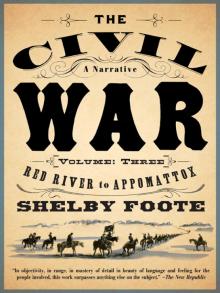 The Civil War: A Narrative: Volume 3: Red River to Appomattox
The Civil War: A Narrative: Volume 3: Red River to Appomattox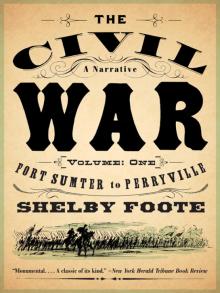 The Civil War: A Narrative: Volume 1: Fort Sumter to Perryville
The Civil War: A Narrative: Volume 1: Fort Sumter to Perryville Jordan County
Jordan County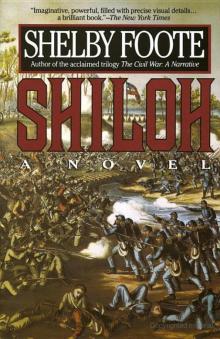 Shiloh
Shiloh Love in a Dry Season
Love in a Dry Season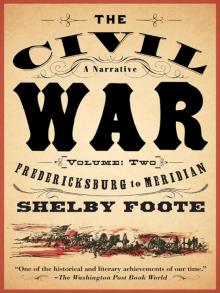 The Civil War: A Narrative: Volume 2: Fredericksburg to Meridian
The Civil War: A Narrative: Volume 2: Fredericksburg to Meridian Chickamauga
Chickamauga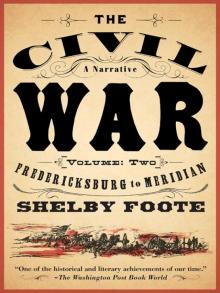 The Civil War: A Narrative: Fredericksburg to Meridian
The Civil War: A Narrative: Fredericksburg to Meridian